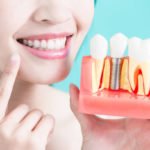Dental bridges, as the name connotes, bridge the gap between missing teeth. They consist of two or more crowns for teeth on one or the other side of the gap; the abutment teeth, which are the anchoring teeth; and false tooth/teeth in between them. Pontics as these false teeth are called, can come in gold, porcelain, alloy or a mixture of these materials. Implants or natural teeth hold these devices.
The Process of Getting a Dental Bridge
On the first visit to get such a device, the dentist makes ready the abutment teeth. He recontours these teeth by filing part of the enamel to provide space for a crown to be placed above them. He then makes impressions of the teeth to serve as a mold that will be used by the dental lab to make the bridge, crowns and pontic. In the meantime, he will create a temporary bridge to protect teeth and gums that are exposed during the time the final version is being made.
On the second visit, the dentist will remove the temporary version and will place the new metal/porcelain bridge, which will be examined and adjusted as needed to make it fit properly. This may require multiple visits in order for the bite and fit of the metal framework to be checked. This actually depends on every patient’s case. If it is a fixed dental bridge, the dentist may put temporary cement on it for a few weeks to ensure proper fit. Then, after another few weeks, the device is permanently cemented.
The Cost of Dental Bridges
When it comes to this type of devices, the costs involved depend on the type of bridge chosen and the part of the country where the procedure is carried out.
The Longevity of Dental Bridges
These devices can be used from five to fifteen years and at times, even longer. It is expected to have a life span of more than 10 years when the patient practices good oral hygiene and regular dental visits.
Eating with a Dental Bridge
When missing teeth are replaced with a dental bridge, it makes eating a lot easier. However, if the person is not yet used to wearing the device, it would help to eat small pieces of soft foods.
Speaking with a Dental Bridge
It is hard to speak clearly with missing teeth. On the other hand, using a dental bridge with the anterior teeth in proper connection enables the person to speak more clearly.
Caring for a Dental Bridge
It is critical for remaining teeth to stay healthy and strong since the outcome of the bridge (based on the type chosen) relies on the foundation that the surrounding teeth provides. Practicing good oral care that includes brushing twice daily, flossing and using a mouthwash everyday prevents tooth decay as well as gum disease than can cause tooth loss.
It would help to ask a dentist/dental hygienist for advice on proper brushing and flossing. Regular cleaning will enable the dentist to diagnose problems right from the start, when it is easier to treat. It is also important to choose a well balanced diet to have proper nutrition.


